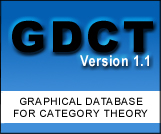
Main Page
for Category Theory(GDCT)
GDCT was developed during May-August 1999 at Mount Allison University by Jeremy Bradbury and Robert Rosebrugh with support from an NSERC USRA.
This is a Java application. It allows for the creation, editing, and storage of finitely presented categories. Categories can be opened from and saved to local (text) files or loaded from a specified server. Once a category file is in memory it can be selected for a three dimensional display of its underlying graph. This display can be manipulated and a chosen shape saved. The display can be printed.
There are several tools available to study a category:
- Make Confluent - applies the Knuth-Bendix algorithm
The display of categories is based on the graph classes developed at Auburn University for Visualizing Graphs with Java (VGJ), a tool for graph drawing and graph layout. The original program was heavily modified for displaying categories. It can be found at www.eng.auburn.edu/department/cse/research/graph_drawing/.
Functors between finitely presented categories can also be created and stored. Functors in memory display their domain and codomain categories, and their action is shown by an animated display.
Some of the algorithms used in GDCT were originally developed in A Database of Categories, a C program written by Ryan Gunther and Michael Fleming with supervision by Robert Rosebrugh, and Category Theory Database Tools, written by Jeremy Bradbury with supervision by Robert Rosebrugh.
Last Modified: June 20, 2000